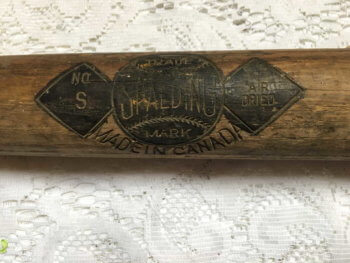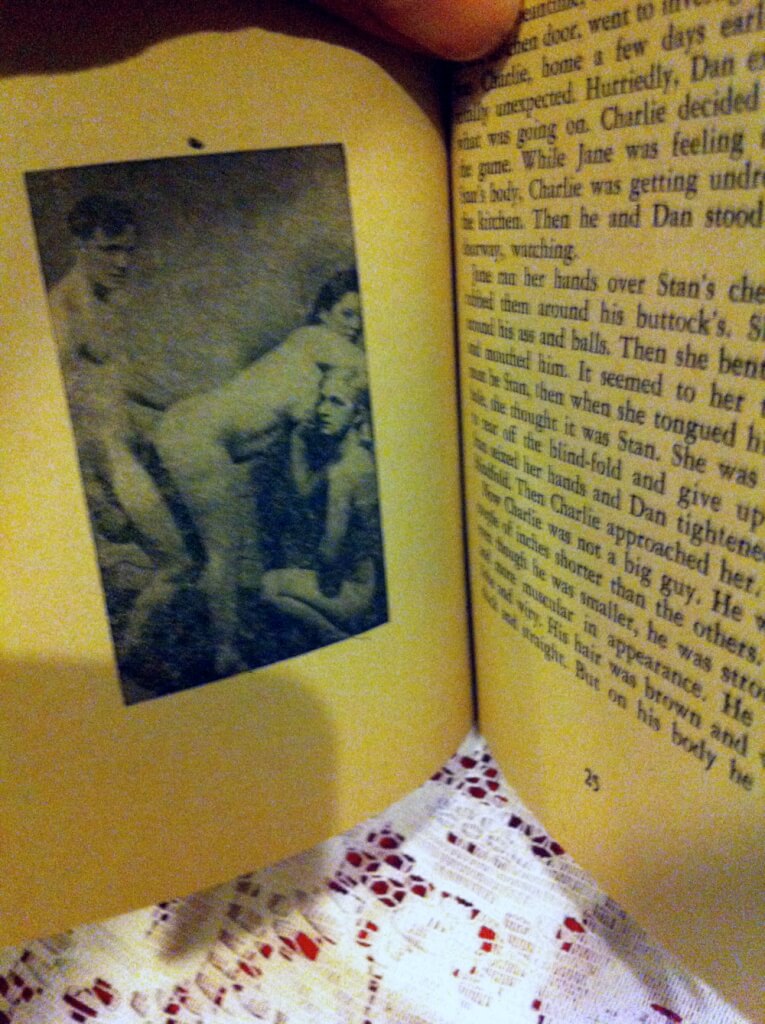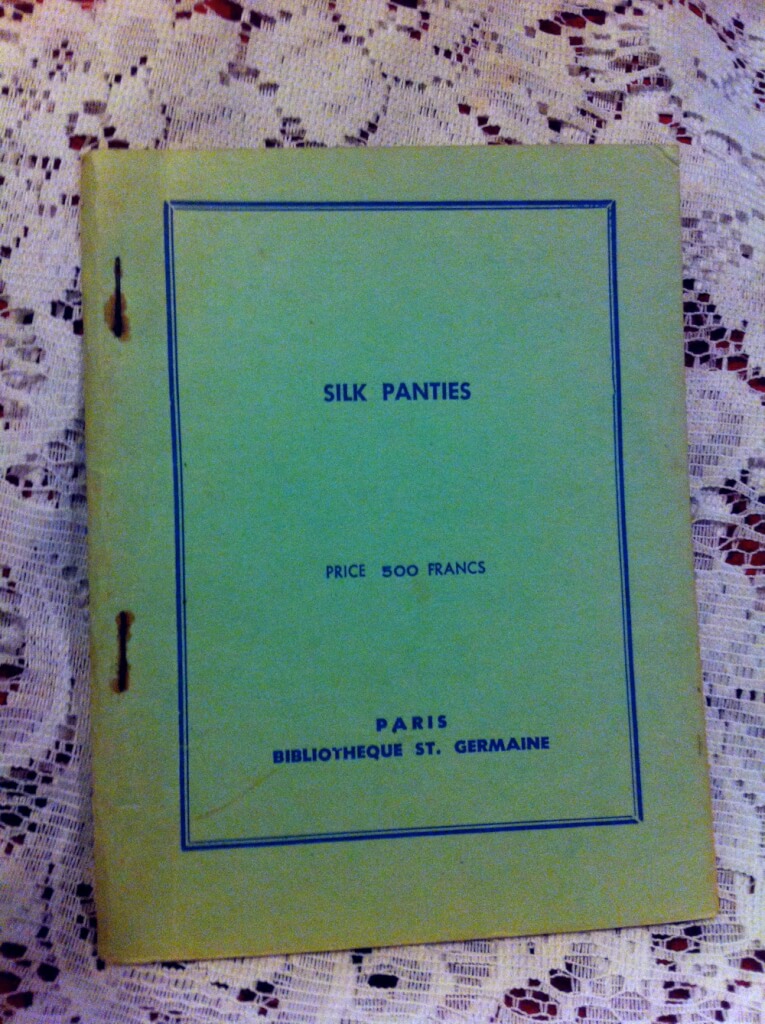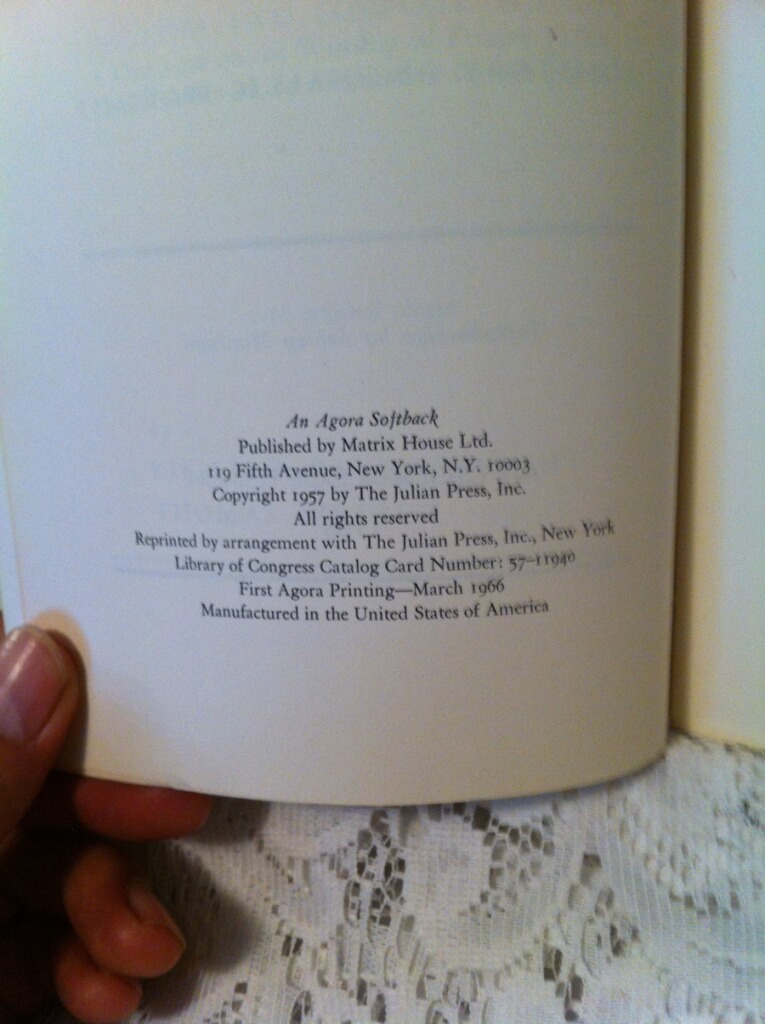-
 The 120 Days of Sodom or: The Romance of The School for Libertinage | Being an English rendering of Les 120 Journées de Sodome done by Pieralessandro Casavini, with an Essay by Georges Bataille, D.A.F. de Sade, trans. Pieralessandro Casavini [Austryn Wainhouse] (Olympia Press, Paris, 1957, Traveller's Companion Series) 7" X 4.5", 3 vol. 192pp 203pp 224pp, original green soft wraps, good condition for age, some bumping and small tears to spine, slight soiling. The 120 Days of Sodom, or the School of Libertinage (French: Les 120 Journées de Sodome ou l'école du libertinage) is an unfinished novel by the French writer and nobleman Donatien Alphonse François, Marquis de Sade, written in 1785. Its plot revolves around the activities of four wealthy libertine men who spend four months seeking out the ultimate sexual gratification through orgies, sealing themselves away in an inaccessible castle in the heart of the Black Forest in Germany with four madams and a harem of thirty-six victims, mostly male and female teenagers. The madams relate stories of their most memorable clients, whose crimes and tortures inspire the libertines to likewise and increasingly abuse and torture their victims to their eventual deaths. Sade states he wrote The 120 Days of Sodom over 37 days in 1785 while he was imprisoned in the Bastille. Being short of writing materials and fearing confiscation, he wrote it in tiny writing on a continuous roll of paper, made up of individual small pieces of paper smuggled into the prison and glued together. The result was a scroll 12 metres long that Sade would hide by rolling it tightly and placing it inside his cell wall. Sade incited a riot among the people gathered outside when he shouted to them that the guards were murdering inmates; as a result, two days later on 4 July 1789, he was transferred to the asylum at Charenton, "naked as a worm" and unable to retrieve the novel in progress. Sade believed the work was destroyed when the Bastille was stormed and looted on 14 July 1789, at the beginning of the French Revolution. He was distraught over its loss and wrote that he "wept tears of blood" in his grief. However, the long scroll of paper on which it was written was found hidden in the walls of his cell where Sade had left it, and removed by a citizen named Arnoux de Saint-Maximin two days before the storming. Historians know little about Saint-Maximin or why he took the manuscript. It was first discovered and published in 1904 by the Berlin dermatologist, psychiatrist, and sexologist Iwan Bloch (who used a pseudonym, "Dr. Eugen Dühren", to avoid controversy). Olympia Press was a Paris-based publisher, launched in 1953 by Maurice Girodias as a rebranded version of the Obelisk Press he inherited from his father Jack Kahane. It published a mix of erotic fiction and avant-garde literary fiction, and is best known for issuing the first printed edition of Vladimir Nabokov's Lolita. In its heyday during the mid-fifties Olympia Press specialized in books which could not be published (without legal action) in the English-speaking world. Early on, Girodias relied on the permissive attitudes of the French to publish sexually explicit books in both French and English. The French began to ban and seize the press's book in the late fifties. Precisely 94 Olympia Press publications were promoted and packaged as "Traveller's Companion" books, usually with simple text-only covers, and each book in the series was numbered. The "Ophelia Press" line of erotica was far larger, using the same design, but pink covers instead of green. In Olympia Press was the first to translate this work into English. "120 Days of Sodom" was first published 1954 (pink covers), and then again in their "Traveller's Companion Series" in 1957 which is this edition.
The 120 Days of Sodom or: The Romance of The School for Libertinage | Being an English rendering of Les 120 Journées de Sodome done by Pieralessandro Casavini, with an Essay by Georges Bataille, D.A.F. de Sade, trans. Pieralessandro Casavini [Austryn Wainhouse] (Olympia Press, Paris, 1957, Traveller's Companion Series) 7" X 4.5", 3 vol. 192pp 203pp 224pp, original green soft wraps, good condition for age, some bumping and small tears to spine, slight soiling. The 120 Days of Sodom, or the School of Libertinage (French: Les 120 Journées de Sodome ou l'école du libertinage) is an unfinished novel by the French writer and nobleman Donatien Alphonse François, Marquis de Sade, written in 1785. Its plot revolves around the activities of four wealthy libertine men who spend four months seeking out the ultimate sexual gratification through orgies, sealing themselves away in an inaccessible castle in the heart of the Black Forest in Germany with four madams and a harem of thirty-six victims, mostly male and female teenagers. The madams relate stories of their most memorable clients, whose crimes and tortures inspire the libertines to likewise and increasingly abuse and torture their victims to their eventual deaths. Sade states he wrote The 120 Days of Sodom over 37 days in 1785 while he was imprisoned in the Bastille. Being short of writing materials and fearing confiscation, he wrote it in tiny writing on a continuous roll of paper, made up of individual small pieces of paper smuggled into the prison and glued together. The result was a scroll 12 metres long that Sade would hide by rolling it tightly and placing it inside his cell wall. Sade incited a riot among the people gathered outside when he shouted to them that the guards were murdering inmates; as a result, two days later on 4 July 1789, he was transferred to the asylum at Charenton, "naked as a worm" and unable to retrieve the novel in progress. Sade believed the work was destroyed when the Bastille was stormed and looted on 14 July 1789, at the beginning of the French Revolution. He was distraught over its loss and wrote that he "wept tears of blood" in his grief. However, the long scroll of paper on which it was written was found hidden in the walls of his cell where Sade had left it, and removed by a citizen named Arnoux de Saint-Maximin two days before the storming. Historians know little about Saint-Maximin or why he took the manuscript. It was first discovered and published in 1904 by the Berlin dermatologist, psychiatrist, and sexologist Iwan Bloch (who used a pseudonym, "Dr. Eugen Dühren", to avoid controversy). Olympia Press was a Paris-based publisher, launched in 1953 by Maurice Girodias as a rebranded version of the Obelisk Press he inherited from his father Jack Kahane. It published a mix of erotic fiction and avant-garde literary fiction, and is best known for issuing the first printed edition of Vladimir Nabokov's Lolita. In its heyday during the mid-fifties Olympia Press specialized in books which could not be published (without legal action) in the English-speaking world. Early on, Girodias relied on the permissive attitudes of the French to publish sexually explicit books in both French and English. The French began to ban and seize the press's book in the late fifties. Precisely 94 Olympia Press publications were promoted and packaged as "Traveller's Companion" books, usually with simple text-only covers, and each book in the series was numbered. The "Ophelia Press" line of erotica was far larger, using the same design, but pink covers instead of green. In Olympia Press was the first to translate this work into English. "120 Days of Sodom" was first published 1954 (pink covers), and then again in their "Traveller's Companion Series" in 1957 which is this edition. -

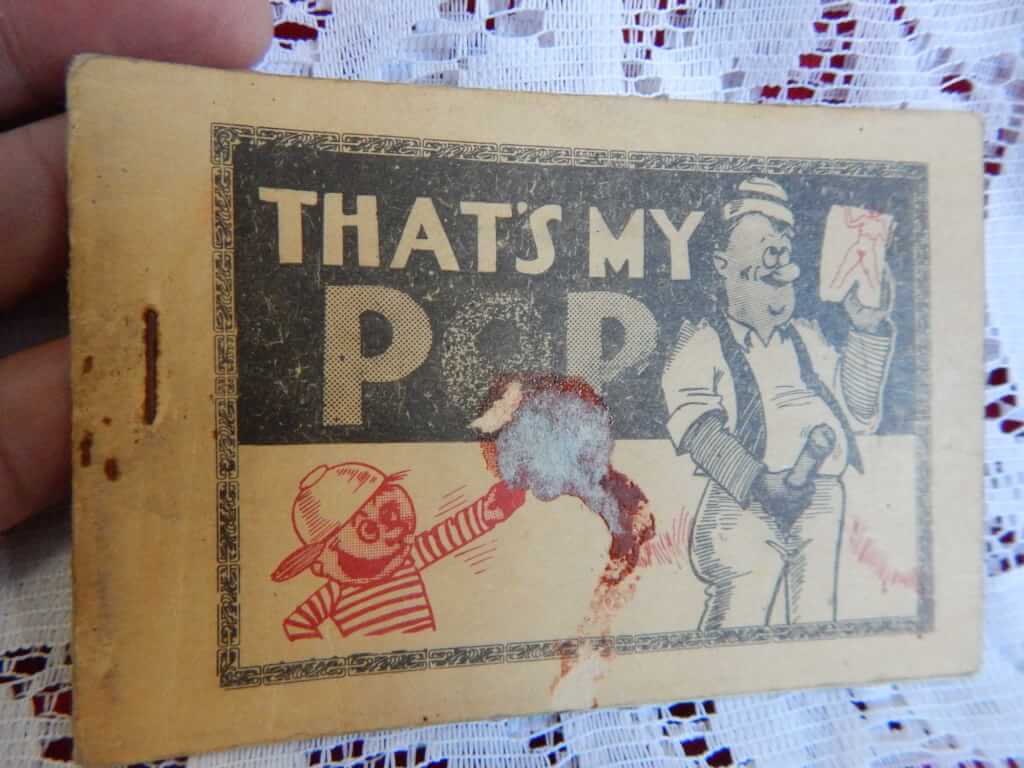 That's My Pop, (np. nd.) 4.5" x 3", 8pp.+2 pages describing sexual positions, pamphlet, stapled Tijuana bibles (also known as eight-pagers, bluesies, gray-backs, Jiggs-and-Maggie books, jo-jo books, Tillie-and-Mac books, and two-by-fours) were little pornographic comic books produced in the United States from the 1920s to the early 1960s.
That's My Pop, (np. nd.) 4.5" x 3", 8pp.+2 pages describing sexual positions, pamphlet, stapled Tijuana bibles (also known as eight-pagers, bluesies, gray-backs, Jiggs-and-Maggie books, jo-jo books, Tillie-and-Mac books, and two-by-fours) were little pornographic comic books produced in the United States from the 1920s to the early 1960s. -
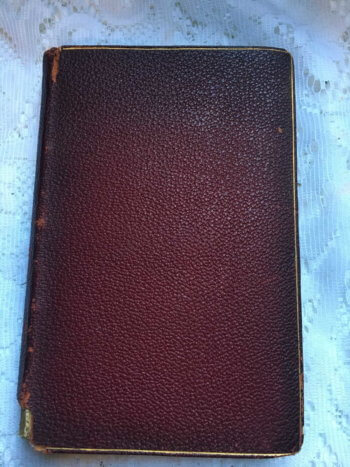
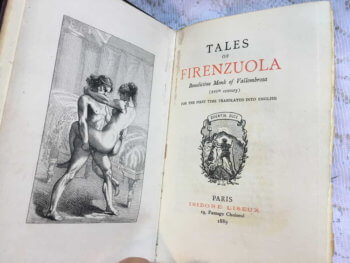 Tales of Firenzuola | Benedictine Monk of Vallombrosa | (XVIth century) | first time translated into English, Agnolo Firenzuola (Isidore Liseux, Paris, 1889) 4.25" x 6.5", xix+180pp., full soft red morroco binding with gilt borders, decorated end papers, deckled edges, hand laid paper, unique frontispiece illustration tipped in, not seen in any other copies online, title page in red and black, good minus condition, corners bumped top of spine is torn, .5" inch of bottom of spine is missing This copy is a rare all-leather first-edition. I have not seen any other copies with this frontispiece and know nothing about it's origin. Originally written in Italian titled Ragionamenti Amorosi (Amorous Reasons), the Tales were written in 1523-24 on the Boccaccian premise of a group of young ladies and gentlemen gathered in a Tuscan villa to tell each other, in turn, stories dealing with love, fortune, fate, virtue, etc. The stories themselves, in their variety and immediacy, offer an insight into sixteenth-century Italian society and its concerns. Agnolo Firenzuola (1493–1545), an Italian poet and littérateur, was born in Florence, September 28th, 1493. He received his name from the town of Firenzaola among the Apennines, where his family originated. Agnolo spent his youth in Siena and Perugia, studying law and living a "life of pleasure". For a short time he practiced law in Rome, but abandoned it to become a monk at Vallombrosa. After the death of Clement VII. he went to Florence, and finally settled at Prato as abbot of San Salvatore. Some authorities have disputed that he ever became an abbot, for the records of his dissolute career do not accord with a monastic life. But whether abbot or gentleman of leisure, a severe illness took him to Prato, where he spent many happy years. He died there or at Rome, about 1545. Firenzuola wrote satirical and burlesque poems; two comedies, ‘I Lucidi’ and ‘La Trinuzia’; ‘Discorsi degli Animali,’ imitations of Oriental fables of animals; ‘Ragionamenti Amorosi,’ novelettes or tales after the fashion of Boccaccio; ‘Dialogo della Bellezza delle Donne,’ and other works. He also wrote a few love poems and ballads, one of the most admired of which is ‘Orozza Pastorella.’ Isidore Liseux (1835-1894) was a French bibliophile and publisher of erotica and curiosa. His publications were mostly rare texts of 16th to 18th century authors, hard to find and little known books which were usually translated and annotated by his friend and associate Alcide Bonneau or by Liseux himself. Liseux and Bonneau, both ex-priests, knew each other since seminary. His books were published in small numbers, on high quality paper, and with excellent typography. His usual printers were Claude Motteroz, Antoine Bécus, and later Charles Unsinger. Liseux's books were published openly as the climate was more permissive in Paris at the time. His books were so well regarded that pirates of his books and even unrelated books bearing his imprint with a false date were published clandestinely into the 20th century. French poet, Guillaume Apollinaire wrote: "The publications of Liseux are more and more sought after because they are correct, beautiful and rare." (Le flaneur des deux rives, 1918).
Tales of Firenzuola | Benedictine Monk of Vallombrosa | (XVIth century) | first time translated into English, Agnolo Firenzuola (Isidore Liseux, Paris, 1889) 4.25" x 6.5", xix+180pp., full soft red morroco binding with gilt borders, decorated end papers, deckled edges, hand laid paper, unique frontispiece illustration tipped in, not seen in any other copies online, title page in red and black, good minus condition, corners bumped top of spine is torn, .5" inch of bottom of spine is missing This copy is a rare all-leather first-edition. I have not seen any other copies with this frontispiece and know nothing about it's origin. Originally written in Italian titled Ragionamenti Amorosi (Amorous Reasons), the Tales were written in 1523-24 on the Boccaccian premise of a group of young ladies and gentlemen gathered in a Tuscan villa to tell each other, in turn, stories dealing with love, fortune, fate, virtue, etc. The stories themselves, in their variety and immediacy, offer an insight into sixteenth-century Italian society and its concerns. Agnolo Firenzuola (1493–1545), an Italian poet and littérateur, was born in Florence, September 28th, 1493. He received his name from the town of Firenzaola among the Apennines, where his family originated. Agnolo spent his youth in Siena and Perugia, studying law and living a "life of pleasure". For a short time he practiced law in Rome, but abandoned it to become a monk at Vallombrosa. After the death of Clement VII. he went to Florence, and finally settled at Prato as abbot of San Salvatore. Some authorities have disputed that he ever became an abbot, for the records of his dissolute career do not accord with a monastic life. But whether abbot or gentleman of leisure, a severe illness took him to Prato, where he spent many happy years. He died there or at Rome, about 1545. Firenzuola wrote satirical and burlesque poems; two comedies, ‘I Lucidi’ and ‘La Trinuzia’; ‘Discorsi degli Animali,’ imitations of Oriental fables of animals; ‘Ragionamenti Amorosi,’ novelettes or tales after the fashion of Boccaccio; ‘Dialogo della Bellezza delle Donne,’ and other works. He also wrote a few love poems and ballads, one of the most admired of which is ‘Orozza Pastorella.’ Isidore Liseux (1835-1894) was a French bibliophile and publisher of erotica and curiosa. His publications were mostly rare texts of 16th to 18th century authors, hard to find and little known books which were usually translated and annotated by his friend and associate Alcide Bonneau or by Liseux himself. Liseux and Bonneau, both ex-priests, knew each other since seminary. His books were published in small numbers, on high quality paper, and with excellent typography. His usual printers were Claude Motteroz, Antoine Bécus, and later Charles Unsinger. Liseux's books were published openly as the climate was more permissive in Paris at the time. His books were so well regarded that pirates of his books and even unrelated books bearing his imprint with a false date were published clandestinely into the 20th century. French poet, Guillaume Apollinaire wrote: "The publications of Liseux are more and more sought after because they are correct, beautiful and rare." (Le flaneur des deux rives, 1918). -
 Tales and Novels in verse of J. De La Fontaine, illustrated with eighty fives[sic] original plates by Eisen (E.F. Bonaventure, New York, 1883, signed by the publisher, hand-numbered #324/400) 5.75″x9″, 2 vol., xiii+252pp, x+334pp, three-quarter bound with brown morocco with gilt borders over marbled boards, 5 raised bands, gilt titles and decoration on spines, top-edge gilt with others deckled, illustrated throughout with protective tissue guards. Jean de La Fontaine (1621-1695) was a French fabulist and one of the most widely read French poets of the 17th century. After a long period of royal suspicion, he was admitted to the French Academy and his reputation in France has never faded since. Evidence of this is found in the many pictures and statues of the writer, as well as later depictions on medals, coins and postage stamps. The numerous works of La Fontaine fall into three traditional divisions: the Fables, the Tales and the miscellaneous (including dramatic) works. He is best known for the first of these, in which a tradition of fable collecting in French verse reaching back to the Middle Ages was brought to a peak. He published 245 fables, across twelve books between 1668 and 1694, exemplify the grace and wit of his age. Unlike many of his models, his fables function less as didactic tools and more as entertaining art. His beasts, humans, and plants are not merely moral-serving abstractions but rather lively actors in elegantly described escapades. Almost equally as popular in their time, his “tales”, Contes et nouvelles en vers (1665), is an anthology of various ribald short stories and novellas collected and versified from prose. They were particularly marked by their archly licentious tone. La Fontaine drew from several French and Italian works of the 15th and 16th centuries, among them The Decameron of Giovanni Boccaccio, Ludovico Ariosto’s Orlando Furioso, Antoine de la Sale’s collection Cent Nouvelles Nouvelles, and the work of Bonaventure des Périers.
Tales and Novels in verse of J. De La Fontaine, illustrated with eighty fives[sic] original plates by Eisen (E.F. Bonaventure, New York, 1883, signed by the publisher, hand-numbered #324/400) 5.75″x9″, 2 vol., xiii+252pp, x+334pp, three-quarter bound with brown morocco with gilt borders over marbled boards, 5 raised bands, gilt titles and decoration on spines, top-edge gilt with others deckled, illustrated throughout with protective tissue guards. Jean de La Fontaine (1621-1695) was a French fabulist and one of the most widely read French poets of the 17th century. After a long period of royal suspicion, he was admitted to the French Academy and his reputation in France has never faded since. Evidence of this is found in the many pictures and statues of the writer, as well as later depictions on medals, coins and postage stamps. The numerous works of La Fontaine fall into three traditional divisions: the Fables, the Tales and the miscellaneous (including dramatic) works. He is best known for the first of these, in which a tradition of fable collecting in French verse reaching back to the Middle Ages was brought to a peak. He published 245 fables, across twelve books between 1668 and 1694, exemplify the grace and wit of his age. Unlike many of his models, his fables function less as didactic tools and more as entertaining art. His beasts, humans, and plants are not merely moral-serving abstractions but rather lively actors in elegantly described escapades. Almost equally as popular in their time, his “tales”, Contes et nouvelles en vers (1665), is an anthology of various ribald short stories and novellas collected and versified from prose. They were particularly marked by their archly licentious tone. La Fontaine drew from several French and Italian works of the 15th and 16th centuries, among them The Decameron of Giovanni Boccaccio, Ludovico Ariosto’s Orlando Furioso, Antoine de la Sale’s collection Cent Nouvelles Nouvelles, and the work of Bonaventure des Périers. -
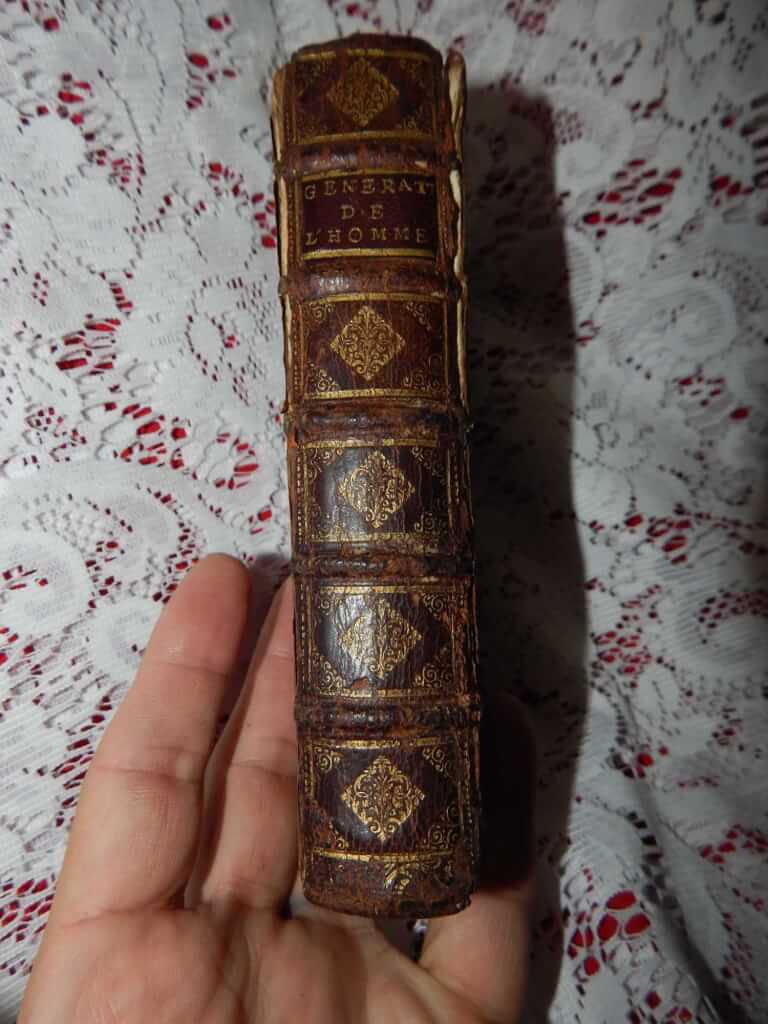
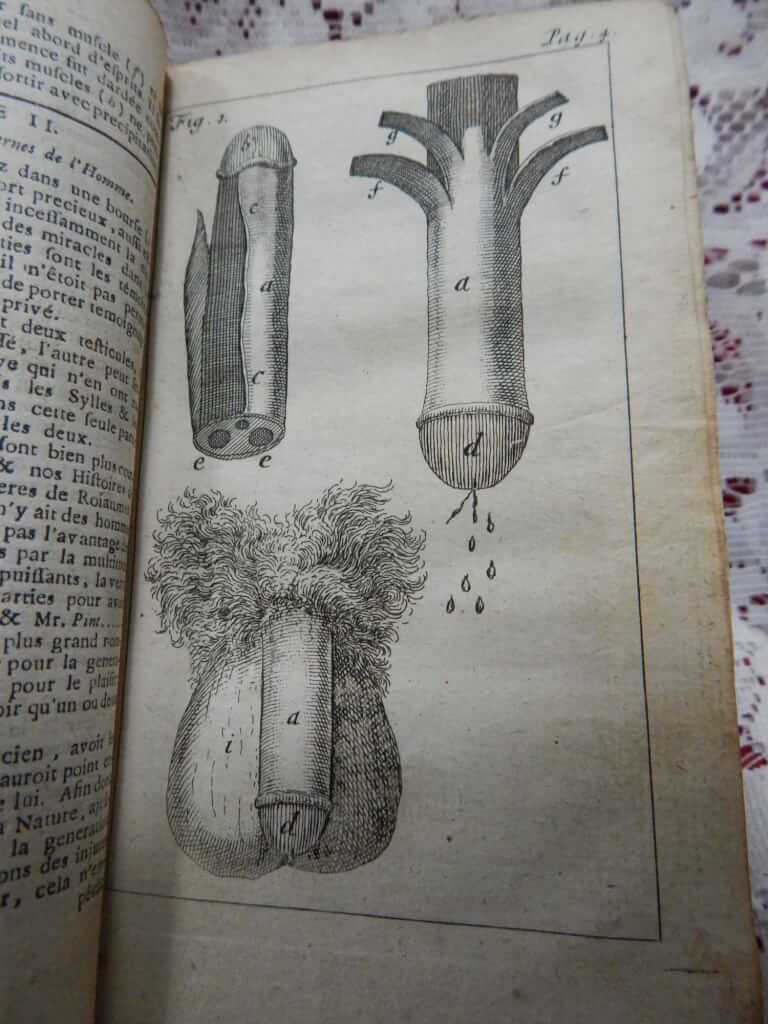 Tableau de l’amour conjugal, ou l'Histoire complète de la génération de l’homme, Nicolas Venette (Claude Joly, Cologne 1712) 3.75"x6", 22+384pp +4, full calf, 5 raised bands, gilt titles and decorations on spine, front boards loose, good condition for age. Illustrated throughout. Nicolas Venette (1633–1698) was a physician, sexologist and French writer. Born in La Rochelle, he studied medicine at Bordeaux where he received his doctorate in 1656. He then went to Paris where he studied under Guy Patin and Pierre Petit, before travelling to Spain, Portugal and Italy. He then returned to La Rochelle, where he became Regius Professor of Anatomy and Surgery in 1668. First published in Amsterdam in 1686 as Tableau de l'amour humain considéré dans l'état du mariage (Table of human love considered in the state of marriage) under the pseudonym Salocini Venetian (anagram of Nicolas Venette), this book, more properly titled Table of conjugal love, or the complete history of the generation of man, is considered to be the first treatise on sexology in West. It proved to be a bestseller and was translated into English, Spanish, German and Dutch. There were 33 editions published sporadically until 1903. This is a rare earlier version, published in 1712. The author discusses four sub-topics with respect to sex: anatomy, reproduction, desire, and impotence/infertility. For each topic, he reviews ancient and medieval authors, adding his own observations or those of later authors, and comments where common sense prevails. The resulting composition has an ambiguous mixture of seriousness and light-heartedness bordering upon erotic literature.
Tableau de l’amour conjugal, ou l'Histoire complète de la génération de l’homme, Nicolas Venette (Claude Joly, Cologne 1712) 3.75"x6", 22+384pp +4, full calf, 5 raised bands, gilt titles and decorations on spine, front boards loose, good condition for age. Illustrated throughout. Nicolas Venette (1633–1698) was a physician, sexologist and French writer. Born in La Rochelle, he studied medicine at Bordeaux where he received his doctorate in 1656. He then went to Paris where he studied under Guy Patin and Pierre Petit, before travelling to Spain, Portugal and Italy. He then returned to La Rochelle, where he became Regius Professor of Anatomy and Surgery in 1668. First published in Amsterdam in 1686 as Tableau de l'amour humain considéré dans l'état du mariage (Table of human love considered in the state of marriage) under the pseudonym Salocini Venetian (anagram of Nicolas Venette), this book, more properly titled Table of conjugal love, or the complete history of the generation of man, is considered to be the first treatise on sexology in West. It proved to be a bestseller and was translated into English, Spanish, German and Dutch. There were 33 editions published sporadically until 1903. This is a rare earlier version, published in 1712. The author discusses four sub-topics with respect to sex: anatomy, reproduction, desire, and impotence/infertility. For each topic, he reviews ancient and medieval authors, adding his own observations or those of later authors, and comments where common sense prevails. The resulting composition has an ambiguous mixture of seriousness and light-heartedness bordering upon erotic literature. -
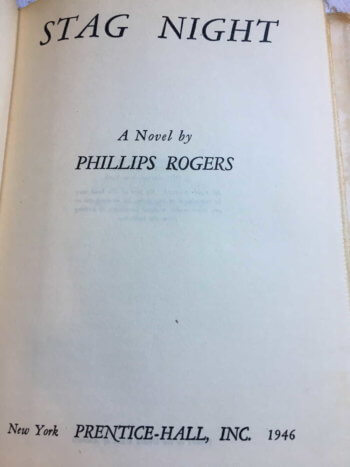
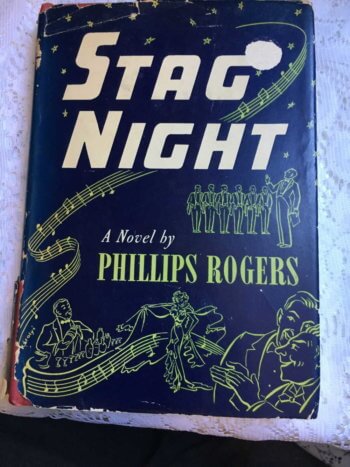 Stag Night, by Phillips Rogers (Prentice-Hall, Inc, New York, 1946) 6" x 8.5", 230pp, hardcover with DJ, red boards with black titles on spine, DJ in fair shape, yellowing throughout, binding good [from Dust Jacket] "Stag Night is a revealing novel about an affair that the men reminisce over for a year and their wives wonder about--the annual Gentleman's Dinner at a country club." "The entire action of Stag Night takes place in one evening at a country club. It begins with the arrival of a tightly girdled whisky-loving Mrs. Riordan ("Fatima") who has for many years given her Dance of the Seven Veils at the Gentleman's Dinner. It ends with tactful and wise Heinz, the head waiter, bidding the police goodnight. In between is depicted the frenzied activity of the chef and the dour bartender, the ribald behavior of some of the stags, the bewilderment of an innocent young refugee dancer, and the mounting excitement as the moment nears for the showing of lewd movies. Tragedy in a grotesque form stalks the evening and at the climax the diners receive the surprise of their lives — and we don't mean the cops in the hall."
Stag Night, by Phillips Rogers (Prentice-Hall, Inc, New York, 1946) 6" x 8.5", 230pp, hardcover with DJ, red boards with black titles on spine, DJ in fair shape, yellowing throughout, binding good [from Dust Jacket] "Stag Night is a revealing novel about an affair that the men reminisce over for a year and their wives wonder about--the annual Gentleman's Dinner at a country club." "The entire action of Stag Night takes place in one evening at a country club. It begins with the arrival of a tightly girdled whisky-loving Mrs. Riordan ("Fatima") who has for many years given her Dance of the Seven Veils at the Gentleman's Dinner. It ends with tactful and wise Heinz, the head waiter, bidding the police goodnight. In between is depicted the frenzied activity of the chef and the dour bartender, the ribald behavior of some of the stags, the bewilderment of an innocent young refugee dancer, and the mounting excitement as the moment nears for the showing of lewd movies. Tragedy in a grotesque form stalks the evening and at the climax the diners receive the surprise of their lives — and we don't mean the cops in the hall." -
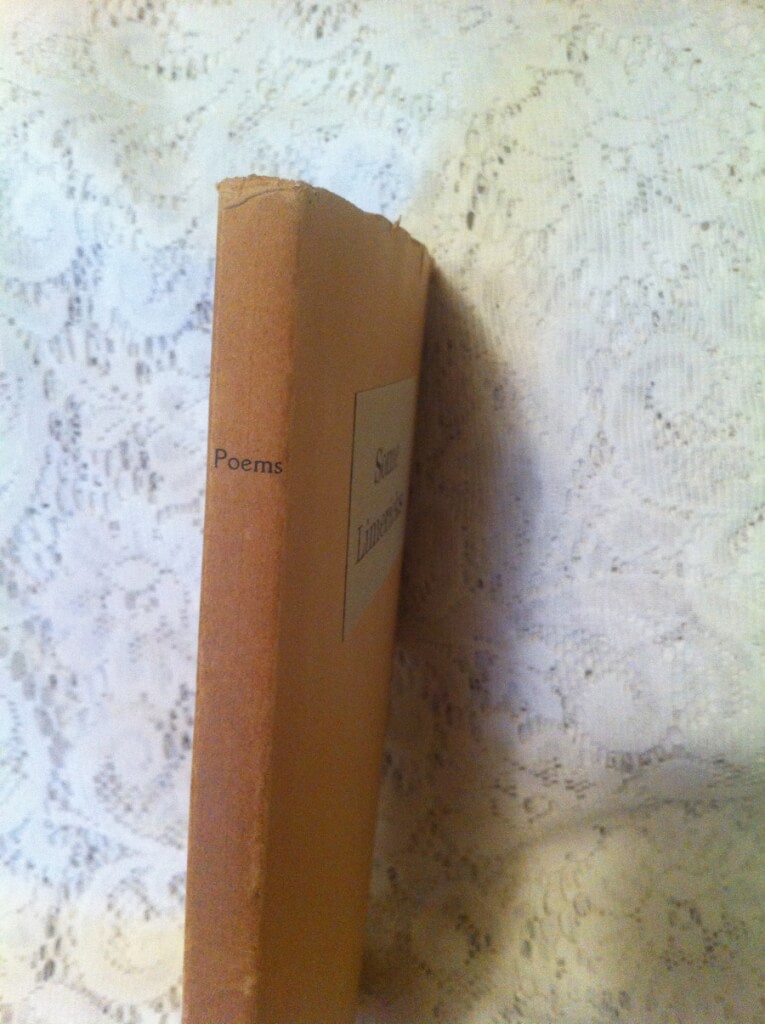
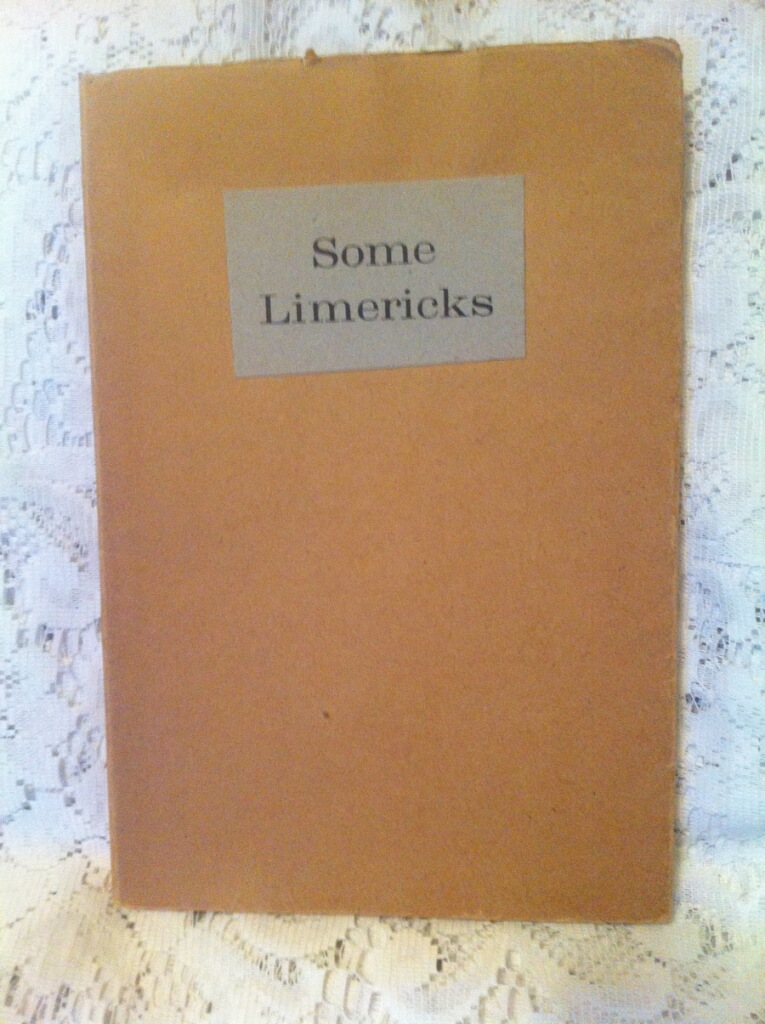 Some Limericks: Collected for the use of Students, & ensplendour’d with Introduction, Geographical Index, and with Notes Explanatory and Critical, by Norman Douglas (Nicholson and Whitney, Boston, 1942 [most likely published in Paris by Maurice Girodias of Olympia Press, early 1950's, a reprint of the Obelisk Press edition of 1939], stated 616/1000 "printed by The Brownbent Press, Boston, Mass.") 5.5" x 8.25", 117pp, near fine condition, unlabeled soft covers, dust jacket slightly warn at top with paper label "Some Limericks", spine of dust jacket simply reads "poems". Norman Douglas is an English author best known for his 1917 novel, South Wind. However, this particular book of his is one of the most pirated books of it's kind. Unable to find a publisher willing to take it on, Douglas published it himself in 1928. It was published by Oblisk Press in 1939 (said to be the last book secured for the company before Jack Kahane's lifetime). This particular edition was published by Mr. Kahane's son, Maurice Girodias, who inherited his father's press, but changed the name to Olympia Press. It is said that this book has everything, blasphemy, incest, paedophilia, bestiality. Accompanying each limericks are entertaining (if not scholarly) notes explaining the supposed origin and/or circumstances by which the rhymes were procured. So obscene and offensive, even Olympia Press, known for it's erotic literature, chose to publish under a false imprint.
Some Limericks: Collected for the use of Students, & ensplendour’d with Introduction, Geographical Index, and with Notes Explanatory and Critical, by Norman Douglas (Nicholson and Whitney, Boston, 1942 [most likely published in Paris by Maurice Girodias of Olympia Press, early 1950's, a reprint of the Obelisk Press edition of 1939], stated 616/1000 "printed by The Brownbent Press, Boston, Mass.") 5.5" x 8.25", 117pp, near fine condition, unlabeled soft covers, dust jacket slightly warn at top with paper label "Some Limericks", spine of dust jacket simply reads "poems". Norman Douglas is an English author best known for his 1917 novel, South Wind. However, this particular book of his is one of the most pirated books of it's kind. Unable to find a publisher willing to take it on, Douglas published it himself in 1928. It was published by Oblisk Press in 1939 (said to be the last book secured for the company before Jack Kahane's lifetime). This particular edition was published by Mr. Kahane's son, Maurice Girodias, who inherited his father's press, but changed the name to Olympia Press. It is said that this book has everything, blasphemy, incest, paedophilia, bestiality. Accompanying each limericks are entertaining (if not scholarly) notes explaining the supposed origin and/or circumstances by which the rhymes were procured. So obscene and offensive, even Olympia Press, known for it's erotic literature, chose to publish under a false imprint. -

 Smiling Jack in "A Forced Landing", (n.p. n.d.) 4.5" x 3", 8pp. pamphlet, stapled Tijuana bibles (also known as eight-pagers, bluesies, gray-backs, Jiggs-and-Maggie books, jo-jo books, Tillie-and-Mac books, and two-by-fours) were little pornographic comic books produced in the United States from the 1920s to the early 1960s.
Smiling Jack in "A Forced Landing", (n.p. n.d.) 4.5" x 3", 8pp. pamphlet, stapled Tijuana bibles (also known as eight-pagers, bluesies, gray-backs, Jiggs-and-Maggie books, jo-jo books, Tillie-and-Mac books, and two-by-fours) were little pornographic comic books produced in the United States from the 1920s to the early 1960s. -
Out of stock
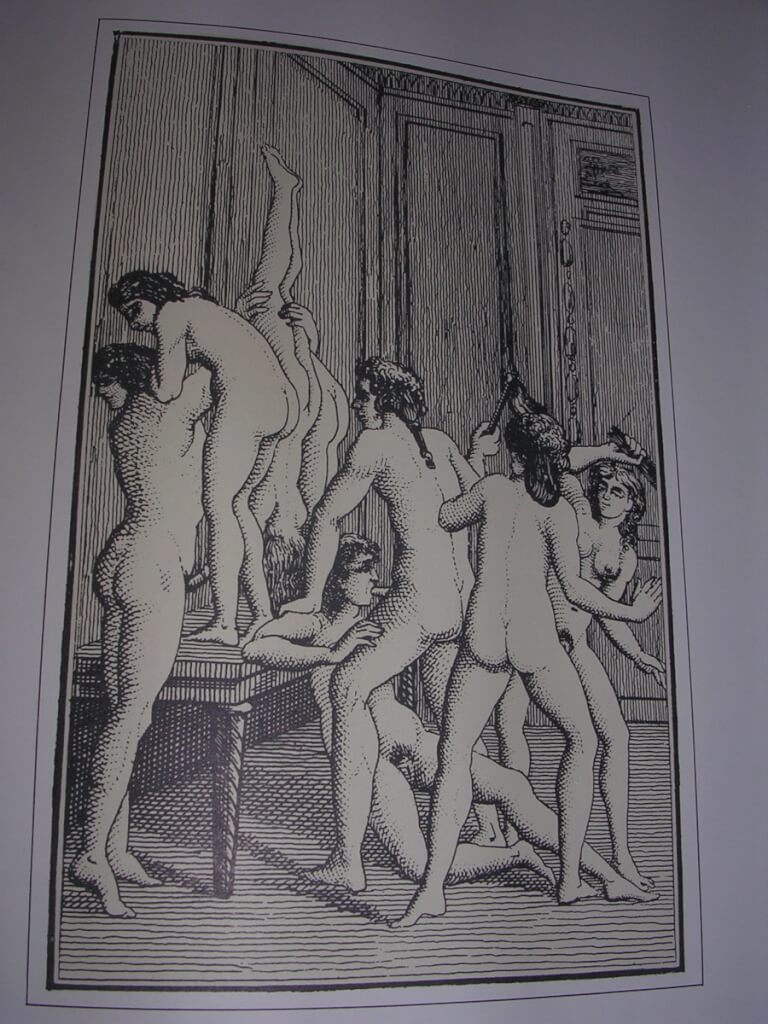
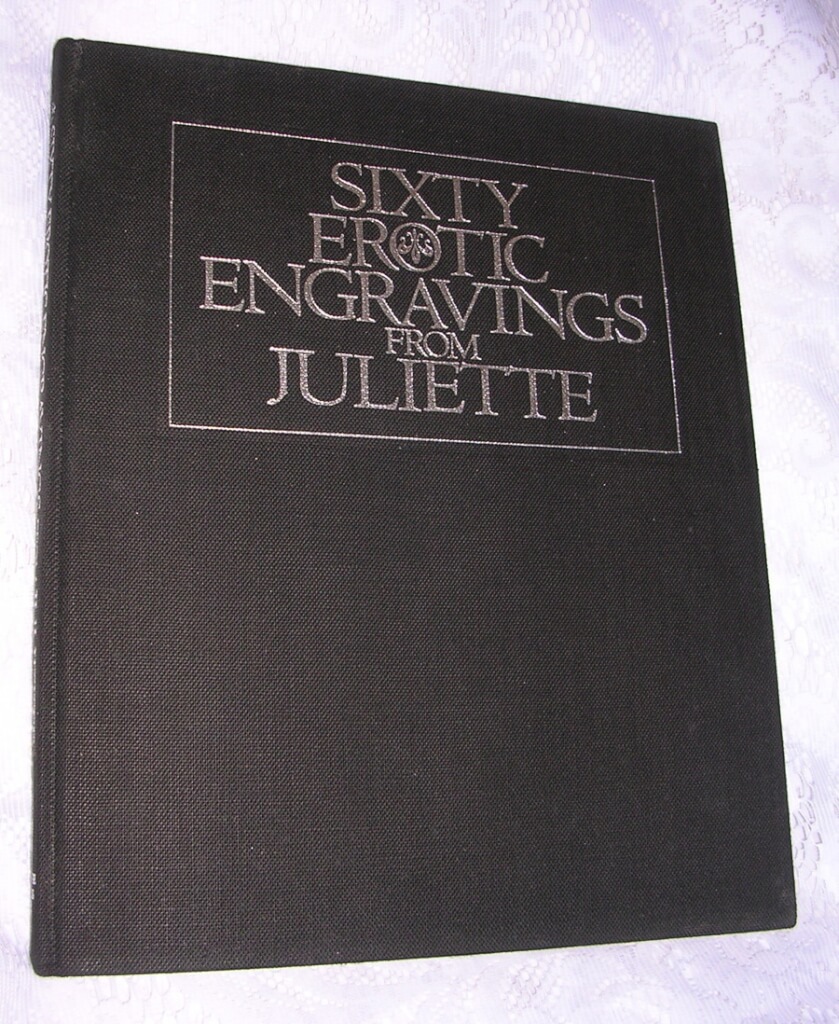 SIXTY EROTIC ENGRAVINGS FROM JULIETTE, Marquise De Sade (Grove Press, Inc., New York, 1969 [first printing]) 11 3/8" X 9 1/2", 60pp, hardback no DJ, good condition 1797 The Marquis de Sade published "Justine, or the Misfortunes of Virtue" and "Juliette or the Prosperity of Vice" (or "vice amply rewarded") together forming 10 volumes of nearly 4000 pages in total; publication was completed in 1801 and included around 100 very explicit engravings. Napoleon Bonaparte ordered the arrest of the anonymous author of Justine and Juliette, and as a result Sade was incarcerated for the last 13 years of his life. Napoleon called the work "the most abominable book ever engendered by the most depraved imagination". Justine and Juliette were published sporadically from the 19th century into the mid 20th century but mostly without any of the engravings from the original. The engravings which appear in this book were reproduced from a copy of that famous 1797 Holland edition. This publication marks the first legal printing of these engravings in the US.
SIXTY EROTIC ENGRAVINGS FROM JULIETTE, Marquise De Sade (Grove Press, Inc., New York, 1969 [first printing]) 11 3/8" X 9 1/2", 60pp, hardback no DJ, good condition 1797 The Marquis de Sade published "Justine, or the Misfortunes of Virtue" and "Juliette or the Prosperity of Vice" (or "vice amply rewarded") together forming 10 volumes of nearly 4000 pages in total; publication was completed in 1801 and included around 100 very explicit engravings. Napoleon Bonaparte ordered the arrest of the anonymous author of Justine and Juliette, and as a result Sade was incarcerated for the last 13 years of his life. Napoleon called the work "the most abominable book ever engendered by the most depraved imagination". Justine and Juliette were published sporadically from the 19th century into the mid 20th century but mostly without any of the engravings from the original. The engravings which appear in this book were reproduced from a copy of that famous 1797 Holland edition. This publication marks the first legal printing of these engravings in the US. -
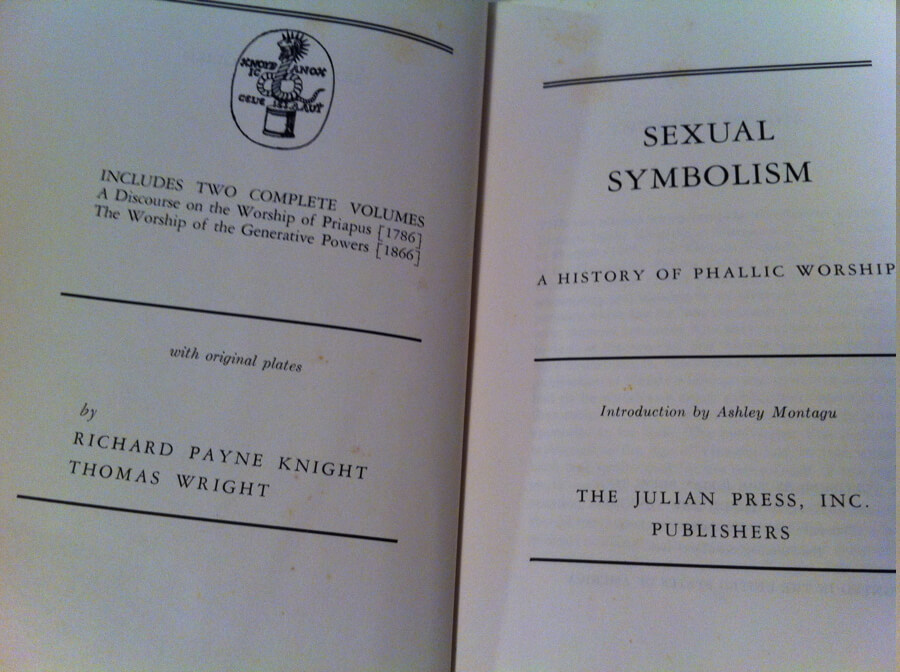
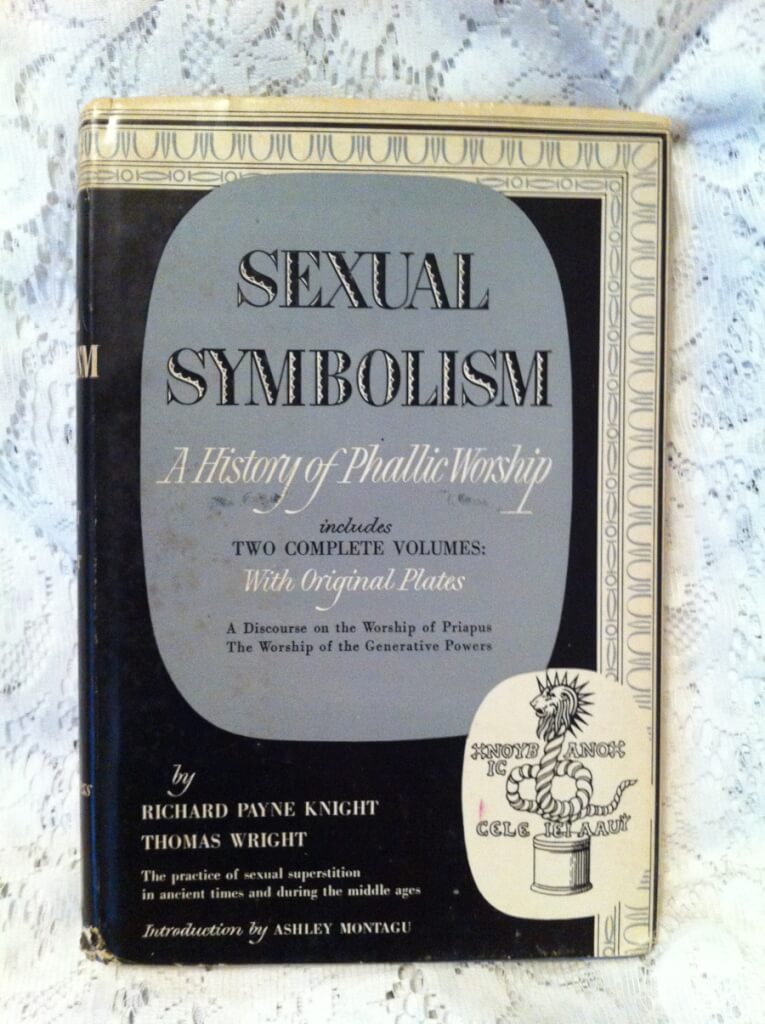 Sexual Symbolism: A History of Phallic Worship, Richard Payne Night & Thomas Wright, intro by Ashley Montagu (The Julia Press, Inc., New York, 1962) 9.5" X 6.5", 217pp + 196pp, hardbound with dustjacket, good condition for age, a few tears in the dustjacket A reprinting of two earlier works with an introduction by Ashley Montagu. The works are: "A Discourse on the Worship of Priapus, and it's connection with the mystic theology of the ancients" [1786] by Richard Payne Knight "to which is added an account of the remains of the worship of priapus lately existing at isernia in the kingdom of Naples by Sir William Hamilton, K.B." and "The Worship of the Generative Powers" [1866] by Thomas Wright
Sexual Symbolism: A History of Phallic Worship, Richard Payne Night & Thomas Wright, intro by Ashley Montagu (The Julia Press, Inc., New York, 1962) 9.5" X 6.5", 217pp + 196pp, hardbound with dustjacket, good condition for age, a few tears in the dustjacket A reprinting of two earlier works with an introduction by Ashley Montagu. The works are: "A Discourse on the Worship of Priapus, and it's connection with the mystic theology of the ancients" [1786] by Richard Payne Knight "to which is added an account of the remains of the worship of priapus lately existing at isernia in the kingdom of Naples by Sir William Hamilton, K.B." and "The Worship of the Generative Powers" [1866] by Thomas Wright -
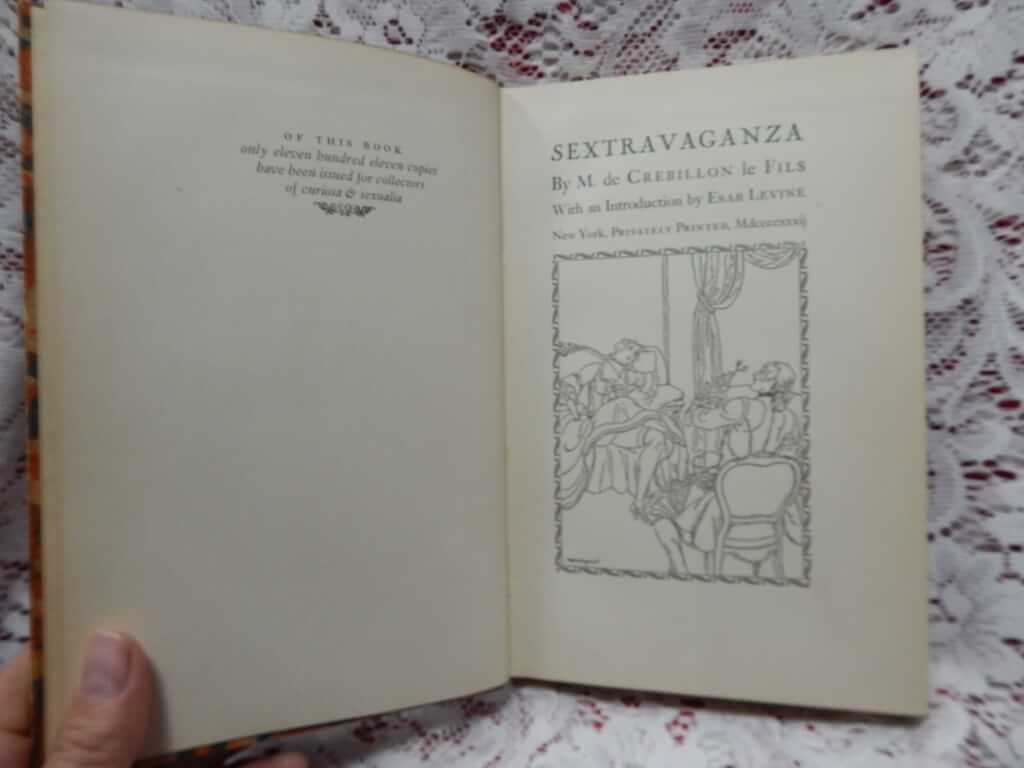
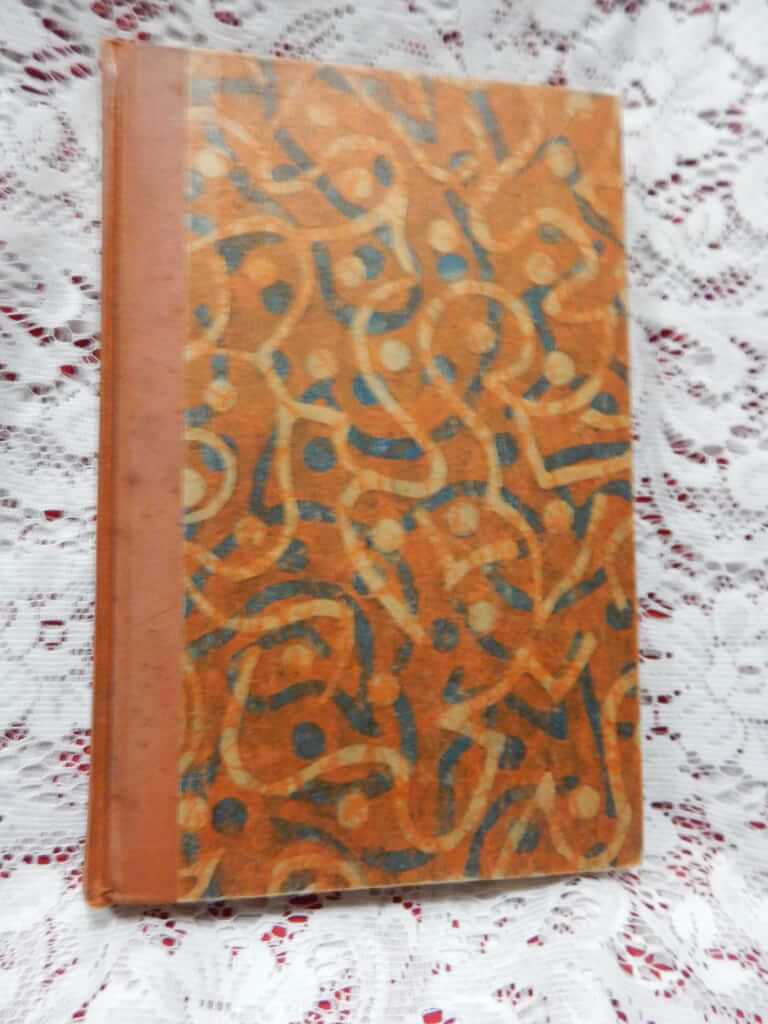 Sextravaganza, by M. de Crebillon le Fils, With and Introduction by Escar Levine, Illustrator unknown (Privately Printed [The Robin Hood House], New York 1932, one of 1111) 6.25"x9.5", 192pp, decorated boards, vellum spine with silver lettering, some spots and bumps but generally a good copy of this edition. Originally titled La Nuit et le moment ou les matines de Cythère [The night and the moment, or the mornings of Cythere], this is Robin Hood House's famous US "private" publication from the 30's and for a long time the only english translation available in the states. Written as a dialog, in the course of one night a man and a woman, each of whom is in love with somebody else, gradually warm up to each other until they forget past pleasures in present passions . Satire, irony, word-play and scandal abound. This edition states "only eleven hundred eleven copies have been issued for collectors of curiosa & sexualia". Claude Prosper Jolyot de Crébillon (1707-1777) was a French novelist. He was called "Crébillon fils" to distinguish him from his father, a famous tragedian, Prosper Jolyot de Crébillon. The publication of Tanzaï et Neadarne, histoire japonaise (1734), which contained thinly veiled attacks on the Papal bull Unigenitus, the cardinal de Rohan and others, landed him briefly in the prison at Vincennes. Publication of Le Sopha, conte moral, an erotic political satire, in 1742 forced him into exile from Paris for several months.
Sextravaganza, by M. de Crebillon le Fils, With and Introduction by Escar Levine, Illustrator unknown (Privately Printed [The Robin Hood House], New York 1932, one of 1111) 6.25"x9.5", 192pp, decorated boards, vellum spine with silver lettering, some spots and bumps but generally a good copy of this edition. Originally titled La Nuit et le moment ou les matines de Cythère [The night and the moment, or the mornings of Cythere], this is Robin Hood House's famous US "private" publication from the 30's and for a long time the only english translation available in the states. Written as a dialog, in the course of one night a man and a woman, each of whom is in love with somebody else, gradually warm up to each other until they forget past pleasures in present passions . Satire, irony, word-play and scandal abound. This edition states "only eleven hundred eleven copies have been issued for collectors of curiosa & sexualia". Claude Prosper Jolyot de Crébillon (1707-1777) was a French novelist. He was called "Crébillon fils" to distinguish him from his father, a famous tragedian, Prosper Jolyot de Crébillon. The publication of Tanzaï et Neadarne, histoire japonaise (1734), which contained thinly veiled attacks on the Papal bull Unigenitus, the cardinal de Rohan and others, landed him briefly in the prison at Vincennes. Publication of Le Sopha, conte moral, an erotic political satire, in 1742 forced him into exile from Paris for several months. -
 Sex Mythology | including an account of the | Masculine Cross, anonymous, Sha Rocco [Abisha S. Hudson] (Privately Printed, London, 1898, one of 200 copies unnumbered) 8.25" X 6", 64pp, quarter white cloth over grey boards, good condition, some bumping to corners, bookplate of Virginia & Edwin Irwin, bookseller stamp of George T. Juckes, London. An account of primitive symbolism and ancient phallic worship including Yoni, Shaga, Hebrew phallicism, Bacchic festivals, sexual rites, religious prostitution, and the mysteries of the ancient faiths. "The phallus and the sexual vocabulary of the Bible are explained within for the first time." The work is anonymous but much of the text comes from the writer of the preface, Sha Rocco, a pseudonym for Abisha S. Hudson. Abisha was born Abisha Shumway Hudson (1819-1905) was born in Oxford, Massachusetts one half of a pair of twins: his twin brother, Abijah T. Hudson, was never far from Abisha; the two trained as physicians together, lived together, and doctored together, in the midwest and on the west coast, even after they married. In April of 1855, Abisha radicalized, ordering a copy of Robert Taylor's infamous Diegesis from the bookstore of the Boston Investigator to hone his arguments as an anti-Christian free-thinker: the subtext for Sha Rocco's Masculine Cross. In 1874, The Masculine Cross and Ancient Sex Worship is published, by Asa K. Butts, a free-thought publisher in New York. Other published editions followed and he contributed to the present book published in London. Abisha was a public Spiritualist and the author of at least one other work "Tree and Serpent Worship" published around 1894, this time using his own name.
Sex Mythology | including an account of the | Masculine Cross, anonymous, Sha Rocco [Abisha S. Hudson] (Privately Printed, London, 1898, one of 200 copies unnumbered) 8.25" X 6", 64pp, quarter white cloth over grey boards, good condition, some bumping to corners, bookplate of Virginia & Edwin Irwin, bookseller stamp of George T. Juckes, London. An account of primitive symbolism and ancient phallic worship including Yoni, Shaga, Hebrew phallicism, Bacchic festivals, sexual rites, religious prostitution, and the mysteries of the ancient faiths. "The phallus and the sexual vocabulary of the Bible are explained within for the first time." The work is anonymous but much of the text comes from the writer of the preface, Sha Rocco, a pseudonym for Abisha S. Hudson. Abisha was born Abisha Shumway Hudson (1819-1905) was born in Oxford, Massachusetts one half of a pair of twins: his twin brother, Abijah T. Hudson, was never far from Abisha; the two trained as physicians together, lived together, and doctored together, in the midwest and on the west coast, even after they married. In April of 1855, Abisha radicalized, ordering a copy of Robert Taylor's infamous Diegesis from the bookstore of the Boston Investigator to hone his arguments as an anti-Christian free-thinker: the subtext for Sha Rocco's Masculine Cross. In 1874, The Masculine Cross and Ancient Sex Worship is published, by Asa K. Butts, a free-thought publisher in New York. Other published editions followed and he contributed to the present book published in London. Abisha was a public Spiritualist and the author of at least one other work "Tree and Serpent Worship" published around 1894, this time using his own name. -
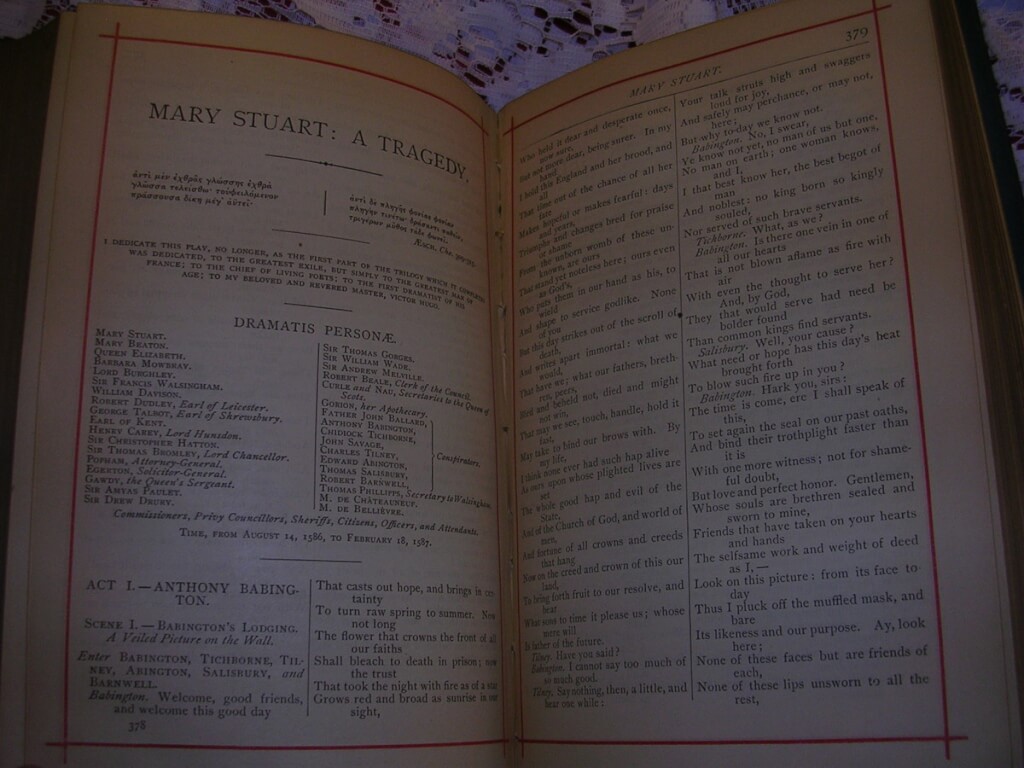
 Selections from the Poetical Works of A. C. Swinburne, from the latest English edition of his works., A. C. Swinburne, ed. R. H. Stoddard (Thomas Y. Crowell & Co., New York, 1884 [first edition, thus.]) 7.5" x 5", xxii, 634pp, Hardcover, raised and gilted blue cloth decorated binding. Gilt edges internal pages framed in red lines. Good condition, bumped and worn corners and spine. Binding tight. Signed by previous owner "Ray E. Searls 1900" Swinburne was an English poet, playwright, novelist, and critic. Considered a decadent poet, although Swinburne perhaps professed to more vice than he actually indulged in; Oscar Wilde stated that Swinburne was "a braggart in matters of vice, who had done everything he could to convince his fellow citizens of his homosexuality and bestiality without being in the slightest degree a homosexual or a bestializer." He was nominated for the Nobel Prize in Literature in every year from 1903 to 1907 and again in 1909.
Selections from the Poetical Works of A. C. Swinburne, from the latest English edition of his works., A. C. Swinburne, ed. R. H. Stoddard (Thomas Y. Crowell & Co., New York, 1884 [first edition, thus.]) 7.5" x 5", xxii, 634pp, Hardcover, raised and gilted blue cloth decorated binding. Gilt edges internal pages framed in red lines. Good condition, bumped and worn corners and spine. Binding tight. Signed by previous owner "Ray E. Searls 1900" Swinburne was an English poet, playwright, novelist, and critic. Considered a decadent poet, although Swinburne perhaps professed to more vice than he actually indulged in; Oscar Wilde stated that Swinburne was "a braggart in matters of vice, who had done everything he could to convince his fellow citizens of his homosexuality and bestiality without being in the slightest degree a homosexual or a bestializer." He was nominated for the Nobel Prize in Literature in every year from 1903 to 1907 and again in 1909. -

 Schnozzle, (n.p. n.d.) 4.5" x 3", 8pp. pamphlet, stapled Tijuana bibles (also known as eight-pagers, bluesies, gray-backs, Jiggs-and-Maggie books, jo-jo books, Tillie-and-Mac books, and two-by-fours) were little pornographic comic books produced in the United States from the 1920s to the early 1960s. Their popularity peaked during the Great Depression era. This book parodies Jimmy Durante.
Schnozzle, (n.p. n.d.) 4.5" x 3", 8pp. pamphlet, stapled Tijuana bibles (also known as eight-pagers, bluesies, gray-backs, Jiggs-and-Maggie books, jo-jo books, Tillie-and-Mac books, and two-by-fours) were little pornographic comic books produced in the United States from the 1920s to the early 1960s. Their popularity peaked during the Great Depression era. This book parodies Jimmy Durante. -
 Sappho: memoir, text, selected renderings, and a literal translation by Henry Thorton Wharton, Sappho, trans. Henry Thornton Wharton, M.A. Oxon. (John Lane [Bodley Head], London, A.C. McClurg & Co, Chicago, 1895 (third edition)) 7.25″ X 4.75″, xx 217pp + 16pp publisher’s list, hardbound, the third edition (this being the first to have its boards decorated by Aubrey Beardsley) green cloth boards with gilt decorations and titles on spine, bottom of the spine states “The Bodley Head and Chicago” reflecting the two publishing houses, top edge gilt, others deckled. Good condition for age, short tear on spine, binding and hinges good, newspaper article attached to back page “A Newly-Found Poem by Sappho” Sappho was a Greek lyric poet, born on the island of Lesbos. The Alexandrians included her in the list of nine lyric poets. Her birth was sometime between 630 and 612 BC, and it is said that she died around 570 BC, but little is known for certain about her life. The bulk of her poetry, which was well-known and greatly admired through much of antiquity, has been lost. But, her immense reputation has endured through surviving fragments. Sappho's poetry centers on passion and love for various people and both sexes. The word lesbian derives from the name of the island of her birth, Lesbos, while her name is also the origin of the word sapphic; neither word was applied to female homosexuality until the 19th century, after this translation by Wharton, the first English translation to acknowledge it. Originally John Lane and Elkin Mathews — The Bodley Head was a partnership set up in 1887 by John Lane (1854–1925) and Elkin Mathews (1851–1921), to trade in antiquarian books in London. It took its name from a bust of Sir Thomas Bodley, the eponymist of the Bodleian Library in Oxford, above the shop door. Lane and Mathews began in 1894 to publish works of ‘stylish decadence’, including the notorious literary periodical The Yellow Book. A. C. McClurg was a Chicago, Illinois based publisher made famous by their original publishing of the Tarzan of the Apes novels and other stories of Edgar Rice Burroughs.
Sappho: memoir, text, selected renderings, and a literal translation by Henry Thorton Wharton, Sappho, trans. Henry Thornton Wharton, M.A. Oxon. (John Lane [Bodley Head], London, A.C. McClurg & Co, Chicago, 1895 (third edition)) 7.25″ X 4.75″, xx 217pp + 16pp publisher’s list, hardbound, the third edition (this being the first to have its boards decorated by Aubrey Beardsley) green cloth boards with gilt decorations and titles on spine, bottom of the spine states “The Bodley Head and Chicago” reflecting the two publishing houses, top edge gilt, others deckled. Good condition for age, short tear on spine, binding and hinges good, newspaper article attached to back page “A Newly-Found Poem by Sappho” Sappho was a Greek lyric poet, born on the island of Lesbos. The Alexandrians included her in the list of nine lyric poets. Her birth was sometime between 630 and 612 BC, and it is said that she died around 570 BC, but little is known for certain about her life. The bulk of her poetry, which was well-known and greatly admired through much of antiquity, has been lost. But, her immense reputation has endured through surviving fragments. Sappho's poetry centers on passion and love for various people and both sexes. The word lesbian derives from the name of the island of her birth, Lesbos, while her name is also the origin of the word sapphic; neither word was applied to female homosexuality until the 19th century, after this translation by Wharton, the first English translation to acknowledge it. Originally John Lane and Elkin Mathews — The Bodley Head was a partnership set up in 1887 by John Lane (1854–1925) and Elkin Mathews (1851–1921), to trade in antiquarian books in London. It took its name from a bust of Sir Thomas Bodley, the eponymist of the Bodleian Library in Oxford, above the shop door. Lane and Mathews began in 1894 to publish works of ‘stylish decadence’, including the notorious literary periodical The Yellow Book. A. C. McClurg was a Chicago, Illinois based publisher made famous by their original publishing of the Tarzan of the Apes novels and other stories of Edgar Rice Burroughs.












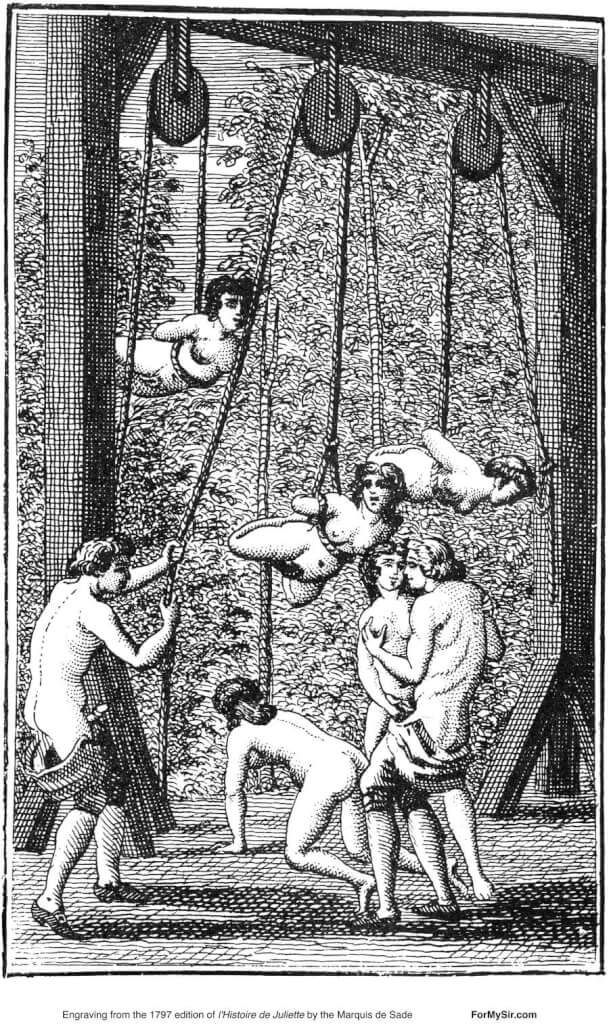


 c. 1927 Actress Colleen Moore using a Star-Rite electric massage vibrator in Hollywood.
c. 1927 Actress Colleen Moore using a Star-Rite electric massage vibrator in Hollywood. 